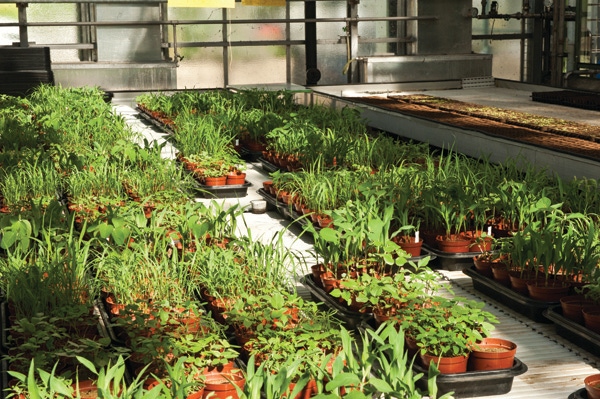February 1, 2013

Very close to the downtown area of Frankfurt, Germany, lies a sprawling 11/2 -sq.-mile industrial park that straddles both sides of the Main River. It’s an impressive sight, with all the trappings you’d expect. It is here where Bayer CropScience houses its global research and development programs of the company’s herbicides.
The industrial park is more than the place where Bayer CropScience has offices and staff. The roots of Bayer CropScience can be traced back to 1863, when on this very site the company that would later become Hoechst was founded.
Like many of the chemical companies in Europe, the company that became Hoechst initially focused on making dyes for the textile industry. Later, the company migrated into pharmaceuticals and later crop protection. At one time, Hoechst was the largest pharmaceutical company in the world and took up the entire industrial park.
The crop protection research and development started in earnest in the 1950s, with first nitrogen production and then the development of herbicides. The early development of the urea herbicides was here. As the herbicide and fungicide business grew, so did research and development at the site. Glufosinate was discovered in its laboratories, and the company was a major developer of safener technology.
“This facility has a long history of strong research and development of crop protection products,” says Hermann Stübler, head of weed control for Bayer CropScience. “We have been pioneers in the area of herbicide development.”
Through various mergers and acquisitions within the entire industry through the 1990s, the key components of the herbicide research and development business, as well as insecticide and fungicide research components, were acquired by Bayer CropScience. And while the industrial park is now occupied with many other tenants, Bayer CropScience remains one of the larger businesses, employing more than 700 people in research and development as well as formulation of active ingredients.
“Working closely with our colleagues around the world, our activities here allow us to discover and identify new candidates for weed control for the global market,” Stübler says.
In-depth research
While identifying new candidates for weed control solutions is a key focus of the activities at this site, the programs have evolved to encompass research that goes beyond herbicide development. There are greenhouses that are used to screen new compounds, but the chemists, biochemists and biologists also look at the market.
“Our thinking extends from models to markets,” Stübler says. “Yes, we have in our research team scientists that look at new molecules. But we also must have a sense of what the market wants and needs. We are in close contact with our colleagues in the field to learn from them how agriculture is changing, and how to solve problems in the future. We are extremely market driven.”
One area that has seen significant investment is the area of herbicide-resistant weeds. Not only is research in Frankfurt focused on new products, but also on how herbicide resistance develops and how producers can best use tools now available to protect their crops.
“The enormity of the problem with herbicide-resistant weeds, especially in the United States, has changed our mind-set somewhat,” explains Harry Strek, head of Profiling and Market Support. “While we still look for new chemistries, we are working to get a better understanding of how herbicide resistance develops and how producers can use current tools to manage weeds.
“We are a company that needs to make a return in order to pay for research where there is no guarantee of success for every candidate we advance,” Strek continues. “Yes, we are still in the business of selling products. But we need to increase the life span of current products on the market in order to bridge the current gap of new developments. So we are using this research to develop systems that diversify a weed management system and extend the life of what we have.”
While companies continue to work on new chemistries, the pipeline for new active ingredients remains limited. Research may develop a new active ingredient, but it may never reach a commercial introduction. “We have found several products with new modes of action, but for one reason or another they can’t be brought to market,” Strek says. “It can range from production issues to toxicity. That doesn’t deter our work, but it does show that there are many, many hurdles to overcome before a product comes to market. That is why it is so important that we also focus on ensuring what we have now remains effective.”
Screening for better solutions
Roland Beffa, team leader for weed resistance research, leads the efforts at Bayer CropScience on two fronts. First, his team receives samples from around the world that go through a myriad of high-tech screenings to not only determine if the weeds are resistant but, if so, exactly what type of resistance is present, and to what compounds and classes of compounds.
The data are extremely important in the battle against herbicide-resistant weeds, Beffa explains. “We can quickly determine the resistance profile in the field and use the results of our diagnostics tests to give the best recommendations,” he says. The lab in Frankfurt is expanding its capabilities and will continue to receive samples from U.S. producers in 2013.
“In about half the samples we receive, we have discovered that resistance is not present,” Beffa says. “That is important as well because we can use that information to discuss with the producer how the product was applied and how to improve its effectiveness.”
Gathering samples from around the world also gives Beffa’s team an in-depth database of weed populations with which to conduct research on weed resistance. “We are working to better understand the mechanism of metabolic resistance. This is the most dangerous for the future, because it can impact a broad number of chemical families,” Beffa says. “Even a relatively new chemical family can already be metabolized by weeds that can degrade a broad range of other compounds.” In layman’s terms: Even new chemistries may not be effective if metabolic resistance is present in a weed.
While the current laboratory diagnostics take one to three weeks (as opposed to growing the weed from seed which can take several months), Beffa is also working to develop a system that would provide in-field diagnostics to determine herbicide resistance. “This is longer term, but ultimately the best solution,” he says. “Having precise diagnostics can help producers formulate a better plan of action.
“We continue to learn more and more about herbicide resistance. And the more we understand, the better processes and treatments we can develop.”
Bringing the next class of herbicide to market is no easy task, not for any of the companies involved in research and development. Herbicide resistance is an issue that continues to garner a bigger and brighter spotlight.
“I love coming to work every morning, because I know that we are learning more every day,” Strek says. “For producers struggling with herbicide-resistant weeds, it can be difficult. But our team is talented and motivated, and we continue to work to bring new solutions to market.”
For more information, visit bayercropscience.com.
About the Author(s)
You May Also Like






